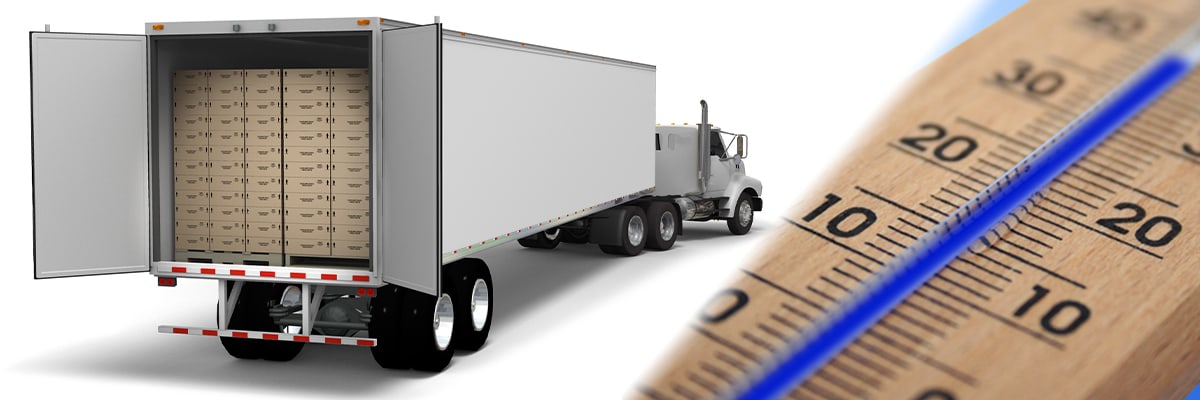Addressing Challenges in Reefer Trailer Temperature Monitoring
How Poor Refrigeration Air Flow Creates Inconsistent Temperature Readings

One of the most common questions customers ask our cold chain experts is why the temperature of a refrigerated truck or warehouse is not the same as the temperature reported on their real-time temperature monitor. This is a critical consideration, especially for products that are more sensitive to temperature excursions, such as vaccines.
This difference in temperature is often an issue of poor refrigeration air flow. To protect your products during transportation and ensure an unbroken cold chain, it is critical to understand why these temperature differences occur and how they can be prevented.
What is Reefer Temperature Monitoring?
Refrigerated temperature monitoring (sometimes called reefer temperature monitoring) is a logistical process of using tools to track the temperature of products in transit. This helps notify organizations of any temperature fluctuations that could impact the product’s quality or shelf life.
Why Is Temperature Monitoring Important for Refrigerated Trucks?
Products in refrigerated trucks need to be kept at their optimal temperature during transit. If a temperature excursion occurs (meaning the product falls out of it’s optimal temperature range), it could harm the product’s quality. If this goes on for an extended amount of time, the product could spoil or even make an unsuspecting customer sick.
This is especially true of life sciences products, like vaccines, which are especially sensitive to temperature fluctuations and can become ineffective in the event of a temperature excursion. When it comes to temperature-sensitive products, organizations have a duty to maintain their cold chain and protect their customers from illness.
How Refrigeration Air Flow Works in a Truck
Trailer refrigeration units are designed to circulate an envelope of cold air around the load. The cold air delivered from the refrigeration unit at the front top of the trailer. Air flows around the load and, depending on the packaging and trailer loading pattern, may also flow through the load.
As the cold air passes through the trailer's interior, heat energy entering the trailer from the outside is absorbed by the trailer's surfaces and the products. The air is returned along the floor back to the refrigeration unit. Finally, the refrigeration unit expels that heat energy absorbed by the circulating air to the outside, and the process starts again.

How Poor Refrigeration Air Flow Creates Hot Spots
A block or disruption in the air circulation will result in warm areas within the trailer. Generally, the door at the end of the trailer is the warmest spot, since it is furthest from the refrigeration unit.
The exact location of the warmest spot can vary due to a number of factors, including the nature of the disruption to the airflow, pallet loading patterns, condition of the trailer, position of the trailer relative to the sun, etc.
Exterior factors are not the only cause of hot spots. Improper loading patterns can disrupt air flow within a refrigerated unit or cause the product to conduct heat from other sources. There should be a gap between the pallet and the wall of the truck as it allows air to flow. Pallets should also not be stacked too high within a truck as the cold air comes from the top of the trailer. Likewise, if a product is touching the trailer’s walls, it may conduct heat from the outside.

Prevent Temperature Abuse by Tracking Refrigeration Air Flow
At Sensitech, we recommend placing temperature monitors on the rear pallet, right side (facing the door) at eye level. This suggested placement covers the areas most likely to heat up and also considers ease of placement and retrieval, providing consistent SOPs, and avoiding damage to the device.
So, why might the temperature recorded by the refrigeration unit differ from readings from those on your temperature monitors? The temperature measurements recorded by the refrigeration unit are typically the supply air and the return air.
For example, if pallets are stacked too high, the air will not properly circulate to the back of the trailer.
Temperature monitoring devices are placed at the rear of the trailer and alert users to temperature problems that are caused by both improper air delivery temperature and inadequate air circulation. With a real-time temperature monitoring device, organizations can identify shipments with poor air flow and intervene to prevent quality decreases or spoilage.

Resolve Your Cold Chain Issues with Sensitech
At Sensitech, our team of experts specializes in refrigeration, food science, life science, logistics, and process improvement. Our professional services and project teams provide services and support to our customers to help them continually improve their cold chains. If your temperature monitors have identified a temperature consistency you believe is caused by poor refrigeration air flow, our team can help.
For more information, contact one of our Sensitech experts today. We welcome your feedback and look forward to answering any other questions. Contact one of our Sensitech experts today.


